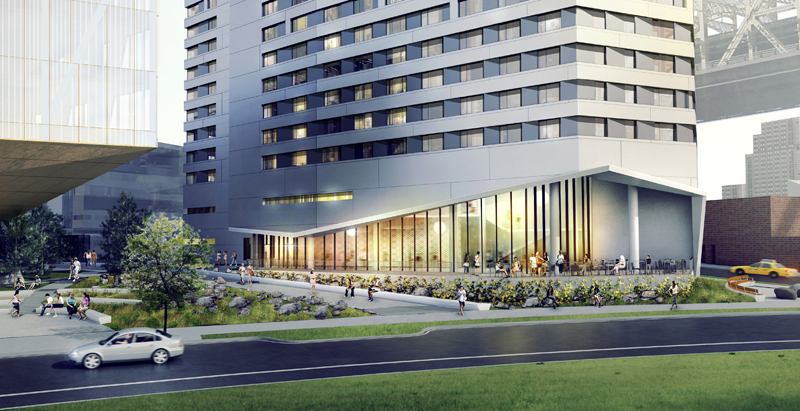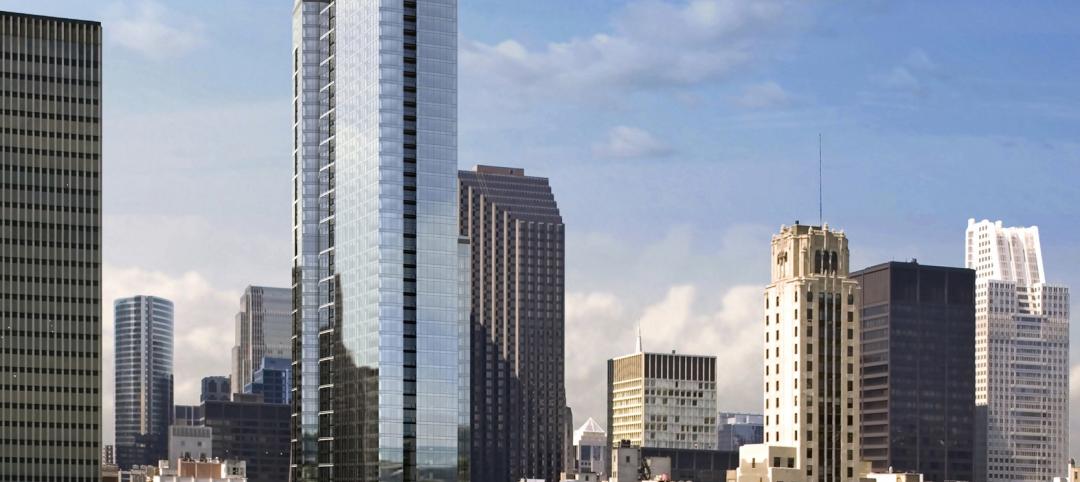Cornell Tech announced last week that the first residential building on its Roosevelt Island campus, developed in partnership with the Hudson Companies, will become the first high-rise residential building in the world built to Passive House standards. Passive House (PH) is the strict international building standard that drastically reduces energy consumption while creating a healthier and more comfortable living environment for a fraction of residents’ usual energy costs.
The building will become the beacon of the Cornell Tech campus and a symbol of the school’s unwavering commitment to innovative sustainability. Construction is set to begin this month on the 270-foot tall building, which will house approximately 350 residential units and is slated to open as part of the campus’ first phase in 2017.
To achieve Passive House standards, Cornell Tech Residential will incorporate a number of sustainability-focused design elements. The façade, constructed of a prefabricated metal panel system, acts as a thermally insulated blanket wrapping the building structure. At the southwest façade, facing Manhattan, the exterior façade opens to reveal a louver system that extends the entire height of the building. This reveal is designed to be the “gills” of the building, literally providing an enclosed exterior space where the heating and cooling equipment live, allowing the building system to breathe.
To achieve Passive House standards, Cornell Tech Residential will incorporate a number of sustainability-focused design elements. The façade, constructed of a prefabricated metal panel system, acts as a thermally insulated blanket wrapping the building structure. At the southwest façade, facing Manhattan, the exterior façade opens to reveal a louver system that extends the entire height of the building.
Low VOC-paint, which limits off-gassing and improves indoor air quality, will be used throughout the building, among many other elements. Compared to conventional construction, the building is projected to save 882 tons of CO2 per year, equal to planting 5,300 new trees.
“Constructing the first Passive House residential high rise in the world is the latest and most exciting example of our effort to set new benchmarks in sustainability and innovation,” said Cornell Tech Dean Daniel Huttenlocher. “We hope this will serve as a model for how Passive House standards can be brought to scale in the United States and create a new template for green design here in New York City.”
“We have spent the past two years working with an incredible team of engineers and designers to establish this new standard for a 26 story building,” said David Kramer, Principal of the Hudson Companies. “We hope that this boundary-pushing development will serve as a living lab and enduring inspiration to the community of next-generation problem solvers who will live within its (well insulated) walls.”
The plans to achieve Passive House standards at Cornell Tech Residential were developed by a team of experts, including Handel Architects, Steven Winter Associates, Buro Happold, Monadnock Construction and co-owner Related Companies.
Luke Falk, Assistant Vice President of Sustainability for Related Companies said, “We are quite literally breaking new ground with the development of the world’s first high-rise residential passive house and it signifies the deep commitment by the entire project team to create a paradigm-shifting campus in New York City. This milestone is also the culmination of unprecedented collaboration between the public and private sector and demonstrates the energy-saving potential of high rise residential architecture that can be achieved with forward thinking partnerships.”

Considered the most rigorous energy efficiency standard in the world, PH buildings consume 60-70% less energy than typical building stock, surpassing modern standards like LEED and NYSERDA. The design also has a tremendous economic benefit for residents: Cornell Tech Residential tenants can expect to see this savings reflected in their electricity bills.
Passive buildings incorporate a super insulated building façade, an airtight building envelope and an energy recovery ventilation (ERV) system to create a comfortable interior climate without drafts and cold spots. The ERV system constantly pulls in fresh air and removes stale air, while recovering the energy in the climate-controlled air leaving the building. The PH requirement for the airtight facade (measured as air changes per hour or ACH) is 0.6 ACH, ten times tighter than typical new construction; new construction buildings average 6-8 ACH, while typical brownstones average 25 ACH.
The new structure, which is being designed by New York City-based Handel Architects LLP, will be the tallest building on Cornell Tech’s campus and an iconic marker. The building’s exterior will shimmer, using a state-of-the-art, color-changing paint that, when reflecting light, naturally shifts color from silver to warm champagne. The interior is designed to provide a comfortable living experience that reinforces the social and intellectual connectivity that is at the heart of the school’s mission. It is geared to further a dynamic environment in which students and faculty can benefit from the synergy of their peers. The building features a number of collaborative spaces, both inside and outside, to facilitate collective academic creativity.
“High-rise multifamily housing is a vital part of the solution to the challenges we are facing with increasing world populations and a changing climate,” said Blake Middleton FAIA, Handel Architects LLP. “The Cornell Tech commitment to innovation was the impetus to rethink how these buildings are designed and built, and we expect this project to be a game-changer, creating a new paradigm for affordable, high-performance buildings to meet this challenge.”
Related Stories
| Mar 11, 2011
Chicago office building will serve tenants and historic church
The Alter Group is partnering with White Oak Realty Partners to develop a 490,000-sf high-performance office building in Chicago’s West Loop. The tower will be located on land owned by Old St. Patrick’s Church (a neighborhood landmark that survived the Chicago Fire of 1871) that’s currently being used as a parking lot.
| Mar 9, 2011
Winners of the 2011 eVolo Skyscraper Competition
Winners of the eVolo 2011 Skyscraper Competition include a high-rise recycling center in New Delhi, India, a dome-like horizontal skyscraper in France that harvests solar energy and collects rainwater, and the Hoover Dam reimagined as an inhabitable skyscraper.
| Mar 2, 2011
How skyscrapers can save the city
Besides making cities more affordable and architecturally interesting, tall buildings are greener than sprawl, and they foster social capital and creativity. Yet some urban planners and preservationists seem to have a misplaced fear of heights that yields damaging restrictions on how tall a building can be. From New York to Paris to Mumbai, there’s a powerful case for building up, not out.
| Feb 11, 2011
Chicago high-rise mixes condos with classrooms for Art Institute students
The Legacy at Millennium Park is a 72-story, mixed-use complex that rises high above Chicago’s Michigan Avenue. The glass tower, designed by Solomon Cordwell Buenz, is mostly residential, but also includes 41,000 sf of classroom space for the School of the Art Institute of Chicago and another 7,400 sf of retail space. The building’s 355 one-, two-, three-, and four-bedroom condominiums range from 875 sf to 9,300 sf, and there are seven levels of parking. Sky patios on the 15th, 42nd, and 60th floors give owners outdoor access and views of Lake Michigan.
| Feb 11, 2011
Chicago architecture firm planning one of China’s tallest towers
Chicago-based Goettsch Partners was commissioned by developer Guangzhou R&F Properties Co. Ltd. to design a new 294,570-sm mixed-use tower in Tianjin, China. The Tianjin R&F Guangdong Tower will be located within the city’s newly planned business district, and at 439 meters it will be one of China’s tallest buildings. The massive complex will feature 134,900 sm of Class A office space, a 400-key, five-star hotel, 55 condominiums, and 8,550 sm of retail space. The architects are designing the tower with multi-story atriums and a high-performance curtain wall to bring daylight deep into the building, thereby creating deeper lease spans. The project is currently finishing design.
| Dec 17, 2010
Condominium and retail building offers luxury and elegance
The 58-story Austonian in Austin, Texas, is the tallest residential building in the western U.S. Benchmark Development, along with Ziegler Cooper Architects and Balfour Beatty (GC), created the 850,000-sf tower with 178 residences, retail space, a 6,000-sf fitness center, and a 10th-floor outdoor area with a 75-foot saltwater lap pool and spa, private cabanas, outdoor kitchens, and pet exercise and grooming areas.
| Dec 17, 2010
Luxury condos built for privacy
A new luxury condominium tower in Los Angeles, The Carlyle has 24 floors with 78 units. Each of the four units on each floor has a private elevator foyer. The top three floors house six 5,000-sf penthouses that offer residents both indoor and outdoor living space. KMD Architects designed the 310,000-sf structure, and Elad Properties was project developer.
| Dec 17, 2010
Vietnam business center will combine office and residential space
The 300,000-sm VietinBank Business Center in Hanoi, Vietnam, designed by Foster + Partners, will have two commercial towers: the first, a 68-story, 362-meter office tower for the international headquarters of VietinBank; the second, a five-star hotel, spa, and serviced apartments. A seven-story podium with conference facilities, retail space, restaurants, and rooftop garden will connect the two towers. Eco-friendly features include using recycled heat from the center’s power plant to provide hot water, and installing water features and plants to improve indoor air quality. Turner Construction Co. is the general contractor.
| Nov 16, 2010
CityCenter’s new Harmon Hotel targeted for demolition
MGM Resorts officials want to demolish the unopened 27-story Harmon Hotel—one of the main components of its brand new $8.5 billion CityCenter development in Las Vegas. In 2008, inspectors found structural work on the Harmon didn’t match building plans submitted to the county, with construction issues focused on improperly placed steel reinforcing bar. In January 2009, MGM scrapped the building’s 200 condo units on the upper floors and stopped the tower at 27 stories, focusing on the Harmon having just 400 hotel rooms. With the Lord Norman Foster-designed building mired in litigation, construction has since been halted on the interior, and the blue-glass tower is essentially a 27-story empty shell.
| Nov 3, 2010
Rotating atriums give Riyadh’s first Hilton an unusual twist
Goettsch Partners, in collaboration with Omrania & Associates (architect of record) and David Wrenn Interiors (interior designer), is serving as design architect for the five-star, 900-key Hilton Riyadh.
















